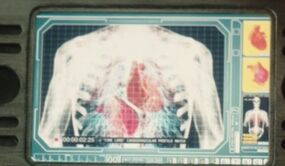Binary vascular system
A binary vascular system was a type of circulatory system in which the blood vessels led to two hearts.
Chen-7, also known as the 1 Day Plague, only affected species with binary vascular systems, such as Apalapucians and Gallifreyans. (TV: The Girl Who Waited)
Baris, a fan of the Tenth Doctor, had a second heart fitted to resemble him more. (PROSE: The Doctor Trap)
Scans of the Ninth Doctor's hearts and later the Eleventh Doctor's hearts showed that the hearts changed position during regeneration at some point. (TV: Dalek, The Power of Three)
Species with a binary vascular system
In general, binary vascular systems were not common amongst humanoids.
Gallifreyans were perhaps the most notable species known to possess a binary vascular systems. (TV: Spearhead from Space, et. al) Being a version of the Time Lords from an alternate timeline, the Word Lords also had a binary vascular system. (AUDIO: The Word Lord)
In the Mutter's Spiral galaxy, a few monopod species and a drone species had two hearts. (PROSE: Tragedy Day)
The Second Doctor once encountered another double-hearted humanoid species called the Dulcians. (TV: The Dominators)
Later, the Eighth Doctor met the Kulan, another race whose overall stamina seemed to be improved over humans by their two hearts. (PROSE: Escape Velocity)
The Kirithons were genetically engineered by the Panjistri to have two hearts. (PROSE: Timewyrm: Apocalypse)
The Apalapucians, residents of Apalapucia, had two hearts. (TV: The Girl Who Waited)
The inhabitants of Skale had two hearts. (PROSE: Parallel 59)
Benefits
The Dominator Rago once told Jamie McCrimmon that beings with single hearts were physically weaker than those with two hearts. (TV: The Dominators)
Similarly, when Henry van Statten performed an invasive scan of the Ninth Doctor, he marvelled at the design and enthusiastically announced he was going to patent it. (TV: Dalek)
A Gallifreyan could survive with only one heart, should the other be punctured, destroyed, or temporarily stop beating, though he or she would be weakened greatly. (PROSE: Managra, TV: The Shakespeare Code, The Power of Three) On one occasion, the Doctor's second heart was extracted from his chest and implanted in Sabbath, leaving the Doctor no longer able to process drugs and deprived of his respiratory bypass system while otherwise capable of operating at a human level, although his remaining heart had to increase its usual rate of beats to a worryingly rapid pulse and he was prone to becoming far more fatigued than usual. At the same time, the heart that Sabbath had stolen endowed Sabbath with the ability to penetrate "deep time" (travelling further away from his homeworld than should be possible), simultaneously creating a link between the Doctor and Sabbath that meant that the Doctor would survive grievous wounds as his heart was still beating in Sabbath, until Sabbath tore the heart out, its death allowing the Doctor to grow a new one. (PROSE: The Adventuress of Henrietta Street, Hope, Camera Obscura) However, if the original heart was repeatedly damaged, even after having a regeneration, it seemed the secondary heart would not be able to sustain a Gallifreyan for long; the person in question would die. A defibrillator could be used to get both hearts working again, in this case. (TV: The Power of Three)
A Gallifreyan in cardiac arrest would need CPR on both hearts. Otherwise, it would prove ineffective. (TV: Smith and Jones)
A binary vascular system provided some level of protection from attack, in that single-hearted humanoids failed to aim correctly when attempting a close-range attack. The Fifth Doctor, for instance, was once stabbed in the chest, but survived because his human attacker aimed for the spot where the human heart would be. Because the Doctor's two hearts were in a slightly different location, the attack was ineffectual. (AUDIO: Son of the Dragon) Even when stabbed in one heart, the second heart would allow the subject to survive the injury, although the subject would require aid to heal the damaged heart. (PROSE: Managra)
Cybermen from Pete's World could detect a binary vascular system, prompting them to take the subject Gallifreyan for further analysis, which at least delayed cyber-conversion. (TV: The Age of Steel)
Hearts and regeneration
A Time Lord's regenerative process was intimately linked to his or her hearts. Some accounts held that Time Lords had only one heart until they regenerated for the first time. (PROSE: The Man in the Velvet Mask) Equally, regeneration could be completely stopped — and the Time Lord therefore killed — if both hearts were pierced or shot simultaneously. Andred and Serena were both killed in this manner, (AUDIO: Imperiatrix, PROSE: World Game) while Cavis was permanently killed after she was decapitated in her first incarnation by her enemy stabbing her mid-regeneration in both her original heart and the place where the second one would grow. (PROSE: The Shadows of Avalon)


